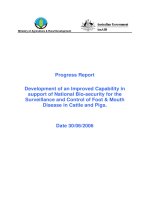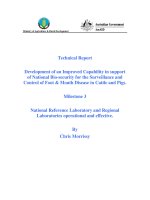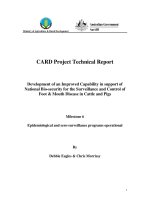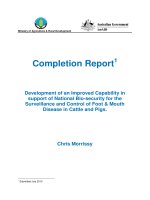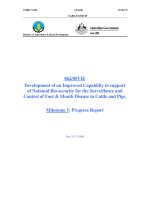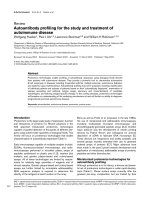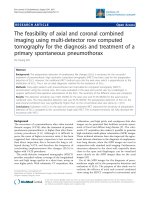physics informed neural networks for the analysis and optmization of structures doctor of philosophy major architectural engineering
Bạn đang xem bản rút gọn của tài liệu. Xem và tải ngay bản đầy đủ của tài liệu tại đây (21.07 MB, 108 trang )
Physics-informed neural networks for the
analysis and optimization of structures
MAI TIEN HAU
February 2023
Department of Architectural Engineering
The Graduate School
Sejong University
Physics-informed neural networks for the
analysis and optimization of structures
MAI TIEN HAU
A dissertation submitted to Faculty of Sejong University
in partial fulfillment of the requirements for the degree of
Doctor of Philosophy in Architectural Engineering
February 2023
Approved by
Professor Jaehong
Major Advisor
Lee
Physics-informed neural networks for the analysis
and optimization of structures
by
MAI TIEN HAU
Approved - ---------------------------------Professor Kihak Lee, Chair of the committee
Approved - ---------------------------------Professor Dongkyu Lee, Member of dissertation committee
Approved - ---------------------------------Professor Seunghye Lee, Member of dissertation committee
Approved - ---------------------------------Professor JongJae Lee, Member of dissertation committee
Approved - ---------------------------------Professor Jaehong Lee, Advisor
ABSTRACT
This thesis is concerned with nonlinear, stability analyses, and size optimization
of truss structures based on physics-informed neural networks (PINNs). For nonlinear analysis one, a robust and simple unsupervised neural network framework is
proposed to perform the geometrically nonlinear analysis of inelastic truss structures. To guide the training process, the loss function built via the total potential
energy principle under boundary conditions (BCs) is minimized in the suggested
NN model whose weights and biases are considered as design variables. And the
training data only contain the spatial coordinates of joints. In each training iteration, feedforward, physical laws, and back-propagation are applied for adjusting
the parameters of the network to minimize the loss function. Once the network
is properly trained, the mechanical responses of inelastic structures can be easily obtained without using any structural analysis as well as incremental-iterative
algorithms. Several benchmark examples regarding geometrical and material nonlinear analysis of truss structures are examined to demonstrate the effectiveness
and reliability of the proposed paradigm.
Subsequently, the proposed
first to analyze the stability of truss structures.
work,
neural network
(NN)
Different
from
most
model
is
existing
is designed to directly locate the critical point by
minimizing the loss function involving the residual load and property of the stiff-
ness matrix which they are established based on the outputs, loads, and BCs. It is
also significant because the first critical point will be located at the training end
corresponding to the minimum
iterative methods.
loss function without utilizing any incremental-
Additionally, this dissertation also develops a Bayesian deep
neural network-based parameterization framework to directly solve the optimum
design for geometrically nonlinear trusses for the first time. In this approach, the
parameters of the network are regarded as decision variables of the structural optimization problem, instead of the member’s
cross-sectional areas. Therein, the
loss function is constructed with the aim of minimizing the total structure weight
so that all constraints of the optimization problem
obtained by supporting fi-
nite element analysis (FEA)
are satisfied. Furthermore,
and are-length method
Bayesian optimization (BO) is applied to automatically tune the hyperparameters of the network. The effectiveness of this model
is demonstrated through a
series of numerical examples for geometrically nonlinear space trusses. And the
obtained results demonstrate that our framework can overcome the drawbacks of
applications of machine learning in computational mechanics. Finally, a physicsinformed neural energy-force network
to directly solve the optimum
sis is completely
removed
(PINEFN)
framework is first constructed
design of truss structures that structural analy-
from the implementation
of the global optimization
in this thesis. Herein, the loss function is designed based on the output values
and physics laws to guide the training. Now
only NN
is used in our scheme to
minimize the loss function wherein weights and biases of the network
are con-
sidered as design variables. In this model, spatial coordinates of truss members
are examined
as input
data, while corresponding
cross-sectional areas and re-
dundant forces unknown to the network are taken account of output. Obtained
outcomes indicated that it not only reduces the computational cost dramatically
ii
but also yields higher accuracy and faster convergence speed compared with recent literature. With the above outstanding features, it is promising to offer a
unified solver-free numerical simulation for solving complex issues in structural
optimization.
Keywords:
Physics-informed,
Geometric
nonlinear,
Structural
stabil-
ity, Hyperparameter optimization, Force method, Critical points, Complementary
energy,
Bayesian
optimization,
iii
Truss optimization
CONTENTS
ABSTRACT.
20.
ce
LIST
OF
TABLES:
LIST
OR
FIGURES:
1
2
ee
2.3:
i cee eees
1 6c
se
6 csi ciinue ee
INTRODUCTION...
ed
ewe
we
6 6 ecto
1...
ee
eee
ee
ewe
vii
8 ee
otis
xi
ew
ee
ee
ee
ee
1
Structural nonlinear analysis
1.2
Sizexoptintization:
ot oF BRE om Om we
4
1.3
Physics-informed neural networks...............
5
lợi
(QJQCHDVỀ
OOS
7
1.5
Organization
ee
9
. « « «sss wewin
2 eek
EER
©...
EMMONS
soe Rw
SELER
eH
EEE
OF
2.2...
NEURAL
NETWORK
TRUSS
STRUCTURES
21
Anoverview..
2.2
PINN for nonlinear analysis...
2.3
oo
EEE
HE ERO
2...
PHYSICS-INFORMED
ANALYSIS
2...
i
1.1
LINEAR
. 2...
ee
FOR
1
NON-
........
0.
2...
ee
11
ee
11
20.20...
00. eee eee
12
2.2.1
Problem siatemenL.........
.
13
2.2.2
Unsupervised learning-based approach amework........
14
PINN for structural stability analysis.................
17
2.3.1
Problem statemeniL.........
.
17
2.3.2
Direct instability-informed neural network framework
20
iv
...
2.4
2.6
Numerical examples
...........
0.0000.
2.4.1.
Material and geometrical nonlinearlles
2.4.2
Geometrical nonlinearity...
2.4.3
Material nonlinearity...
2.4.4
Structural stability...
Comebusiovis
BAYESIAN
. vv
DEEP
ETERIZATION
oe
eww
NEUARL
2.2...
2...
0...
waras
FOR
0...
2.2.02...
00000004
ee
ee
8 8 ee
ee
Be
PARAM-
OPTIMUM
DESIGN
STRUCTURES..................
Imroduelon......
3.2
Statement of structural optimization problem
3.3.
BDNN-based parameterization framework
3.5
000000004
2.0.2...
0.0.00 0004
3.1
3.4
eee
...........
NETWORK-BASED
FRAMEWORK
OEFNONLINEAR
we
eee
.
ch
hy
vẻ
ky vở
............
..............
3.3.1
DNN-based parameterization model
3.3.2
Hyperparameter tuning
.............
.................00.
Numericalexamples..........
. .
0000 pee ee eee
34,1
25-bar space truss
«sees
3.42
52-bardometruss
...
2.0.0.0...
..... 0.0000.
3.4.3
56-bar space truss
2...
0...
344
[20-bar dome truss
Conclusions
..
FOR
ơn...
«oe
a aE
EER EE
EH
0.0... ee
ee
eee
ee
EMM
ee
OBS
eee
ee
2...
PHYSICS-INFORMED
WORK
a0.
oe
ee
NEURAL
STRUCTURAL
ENERGY
FORCE
OPTIMIZATION
NET-
.........
ỘỚIẶẶÁa....
4.2
Structural optimization based on energy-foree methods........
4.3
Physics-informed neural energy-force network
4.4
Numericalexamples
............
........
20.200. 00: eee eee eee
4.5
5
AA
fRendbar truest
4.4.2
200-bar planar truss
4.4.3
25-barsDpacelTUSS
.......
444
72-bar space truss
.....
44.5
em
opm oO we Me
1...
2.
ee
106
120
120-bardometruss...................000.
126
....
ec
ce
AND
<2
2 4 4
Q2
0.0...
peewee
FUTURE
eee
EHH
va
0.002
ey
TẾ TP SE
130
WORK..............
131
ENN
EE
ee
eee
ee
EEE
ee
EEE
EER
EHS
ee
2...
osiciccie
ee
ee
6 ci
131
133
ee
ee
ee
PUBLICATIONS
ABSTRACT
ew
eee
Comelusions
OF
RM
117
REFERENCES.
LIST
eR
và
CONCLUSIONS
`.
se
111
2.
..
wv
ee
Comwebusiotig
Sil
« «sso www
ee
ee ens
eee
ee
wom
135
150
IN KOREAN
..
1...
ee
ee
152
ACKNOWLEDGEMENTS
..
1...
eee
ee ee
155
vi
LIST
21
Type
of material,
network
problems..........
222
OF
.
TABLES
architecture,
and epoch
.
xa
Comparison of joint displacements and energy for 6-bars truss with
different solution techniques and different materials.
2.3
for different
........
Comparison of member forces for 6-bars truss with different solution techniques and diferent materials.................
2.4
Comparision of joint displacement results for the 31-bars truss with
điÑferent algorithms and various materials...............
2.5
Comparision of member forces for the 31-bars truss with different
algorithms and various materials................
2.6
Loading
conditions
nonlÌinearltY........
3ã
.
geometrical
. cvkg
2...
kg
.-.aAdaa
. ..
. aÁẶẶ..
Comparison of member forces for 25-bars truss with various loading
@OMdvIONS. . vv
2.9
space truss with
Comparison of displacements for 25-bars truss with various loading
conditions...
2.8
for the 25-bar
ve
ee
Rw
aa
woe
ee
ee
ee
ee
ee
Re
Comparison of error percentage of different algorithms with FEM
forthe
25-bar truss:
« sem
ees
vii
BRR
RE
EERE
ERE
EM
MRS
2.10
Comparison of deflection results for the 52-bar dome truss obtained
by different algorithms.
2.11
...........
Comparison
.
of member
. Q0
2...
Comparison
©...)
of member
ee
eee
ee
2...
©...
2.
2...
ee
ee
ee
Ha
Comparison results obtained for the two-bar truss in searching the
..............00.
Comparison results obtained for the two-bar truss in searching the
first snap-through point with varying Ky.
2.18
ee
forces for the 21-bar truss with different
first snap-through point with Ky=0.
2.17
2.
Comparison of error percentage of different algorithms with ILM
for the 21-bar truss).
2.16
0...
2
algorithms and various materials...
2.15
va
Comparison of error percentage of different algorithms with ILM
for the 10-bar truss.
2.14
Q cv
forces for the 10-bar truss with different
algorithms and various materials...
2.13
eee
Comparison of member forces for 52-bars truss obtained by different algorithms...........
2.12
0.000000
Comparison
..............
of results of the triangular truss dome
for searching
the bifuireation pOÏnE.........ee
2.19
Loading conditions for dome truss with 24 bars...............
2.20
Comparison
results obtained for 24-bar dome
the first critical pointy
truss in searching
gssyeees
22a RE REE EEE EROS OS
3.1
Configuration space for the hyperparameters of the network
3.2
Material properties, upper and lower bounds on design variables.
3.3
Loading condition for the 25-bar space truss...............
viii
...
.
70
Tổ
3.4
Optimum
hyperparameters of the network obtained using the BO
with different acquisition functions for the 25-bar space truss.
3.5
...
73
Statistics of the optimal weight with different acquisition functions
for the 25-bar space truss.
. 2...
ee
73
3.6
Comparison of optimal results for the 25-bar space truss.
.....
75
3.7
The displacement constraints of the 25-bar space truss... .....
75
3.8
Optimum hyperparameters obtained by using the BO for different
PEODIGMIS:
sg
gk
kde
EMMSEH
MS
GRR
RE
EERE
LEAH
EMBED
78
..... .
78
.....
79
3.9
Statistics of the optimal weight with different problems.
3.10
Comparison of optimal results for the 52-bar dome truss.
3.11
The displacement constraints of the 52-bar dome truss........
79
3.12
Comparison of optimal results for the 56-bar space truss.
.....
83
3.13
The displacement constraints of the 56-bar space truss...
.....
83
3.14
Comparison of optimal results of the 120 dome truss... ......
87
3.15
The displacement constraints of the 120-bar dome truss. ......
87
4.1
Hyperparameters for the benchmarks tested in this study.
4.2
Comparison of the obtained results for the 10-bar truss with the
first loading condition.
4.3
2...
Comparison
eseaw meas
eee
108
sa
ee
ee
ee
ee
Be we
me
109
...
2...
..
20.2...
0000084
110
Error of the constraints for the 10-bar planar truss with the second
loading condition...
4.6
ee
of the obtained results for 10-bar planar truss with
the second loading condition.
4.5
. 0...
106
Error of the constraints for the 10-bar planar truss with the first
loading condition: . 6
4.4
..
.....
2...
ee
ee 110
Design variables of the 200-bar planar truss... ...........
ix
112
47
Optimization results obtained for the 200-bar planar truss.
...
. 115
4.8
Error of the constraints for the 200-bar planar truss. ........
116
4.9
Loading conditions for the 25-bar space truss (Kips).
........
118
4.10
Stress limitation for the 25-bar space truss................
118
4.11
Optimization results obtained for the 25-bar spaece truss........
119
4.12
Error of the constraints for the 25-bar space truss.
.........
119
4.13
Loading conditions for the 72-bar space truss (kips).
........
121
4.14
Optimization results obtained for the 72-bar space truss (Case 01).
122
4.15
Error of the constraints for the 72-bar planar truss (Case Ol).
4.16
Optimization results obtained for the 72-bar space truss (Case 02).
4.17
Error of the constraints for the 72-bar space truss (Case 02).
4.18
Optimization results obtained for the 120-bar dome truss.
4.19
Error of the constraints for the 120-bar dome truss..........
. . . 122
124
. . . 125
..... 129
130
LIST
OF
FIGURES
1.1
Flowchart depicting the data-driven approach for structural analysis.
12
The schematic process of PINN for linear elasticity problem...
Ded
Deformation oŸ a space truss elemen...................
2.2
The whole process of an unsupervised
..
learning-based framework
for geometrically nonlinear analysis of inelastic truss structures.
. .
2.3
Schematic representation of snap-through and bifurcation points.
2.4
Indirect approach using bi-section method.
2.5
The whole process of the direct instability-informed neural network
framework.
.
.............
2.2...
ee
2.6
Stress—strain relationships considered in the analysis. .......
Đã
A 6-bar planar truss structure.
2.8
The convergence histories of the loss function for the 6-bar truss
with the materials MAT3
2...
2...
ee
and MATA..................
2.9
A 31-bar planar truss structure...)
2.10
The convergence histories of the loss function for the 31-bar truss
wilhalifieventomteriale.
2.11
ww
2...
aan
Schematic of a 25-bar space truss.
xi
14
a ee
ee
2...
2...
ee
ew
2...
ee
ee
ee
ee
we
ee an
000000004
15
18
2.12
52-bar dome space truss structure.
2.13
The convergence history of the loss function for the 52-bar dome
WUE
s oe
Ree
EE
ER
...
2...
ee
36
EMRE
ER REE EE ES Sw we
38
2.14
A 10-bar planar truss structure... 2...
ee
39
2.15
21-bar two-span continuous truss siructure................
41
2.16
Tworbar planar truss.
44
2.17
The loss convergence history of the two-bar truss with K, =0.
2.18
Load-deflection curve for the two-bar truss with Kk, =Q.......
47
2.19
Effect of the spring stiffness on the structural stability........
47
2.20
Triangular truss dome............
. .
ee
ee
49
2221
Load-deflection curve and critical points of the triangular truss dome
51
2.22
Star dome truss with 24 bars........
52
2.23
Case O1: Load-defection
Choe WOUBE.
2.24
mm
ge
ee
SE
.
BE
BS
BE
BỤ BoNn SỈ HỆ Re 3
..
ee
46
curve and critieal points of the 24-bar
eo
OO aE
Oe
ee
EM
MUO
OE
...
ác Các CÁC CÁC HE HE HP HP
RRR
RE
EEE
ER
EROS
. Q Q Q Q Q ng
55
56
y
a
57
Schematic of integration of BDNN-based parameterization framework for structural optimization
3.2
c
Case 03: Load-deflection curve and critical points of the 24-bar
đome fFUSS............
3.1
mm
3a
Case 02: Load-deflection curve and critical points of the 24-bar
KHONG URE:
2.25
cc
:s « «
...............0008.
62
Anexample of EI based Bayesian optimization of a one-dimensional
minimization problem. ............
0.00 eee eee eee
69
3.3
A 25-bar space truss structure.
71
3.4
The convergence
2...
histories of the HPO
space truss structure...
6.
ee
xii
2...
ee
eee
using BO
for the 25-bar
. . .eắe he...
74
3.5
Iteration history of the SQP
for the 25-bar space truss.
3.6
algorithm
for different initial areas
©...)
ee
The weight convergence histories of the optimal network and other
studies for the 25-bar space truss...
2...
0...
02..0.20.
0005
3.7
Schematic of a 52-bar dome †russ sfrueture................
3.8
The convergence history of the HPO using BO for the 52-bar dome
truss siTU€EUF©.......
3.9
.
hư
vờ
Tờ
ky
The weight convergence histories of the optimal network and other
works for the 52-bar dome truss.
.............-...004
3.10
A 56-bar space truss øfUEEUF€.
3.11
The convergence history of the HPO using BO for the 56-bar space
truss siTU€EUF©.......
3.12
. . . . .
HQ
ee
.
hư
vờ
ee
Tờ
ky
The weight convergence histories of the optimal network and FEADE for the 56-bar space truss... 2... ee
3.13
120-bar dome space truss structure.
3.14
The convergence histories of the HPO
dome truss structure...
3.15
..........000.
using BO
for the 120-bar
2...
ee
The weight convergence histories of the optimal network and FEADE
4.1
©...
for the 120-bar dome truss.
..
Process of structural optimization.
2...
0.000.200.0200
00045
(a) Conventional approach in-
cluding optimizer algorithm and structural analysis. (b) Framework
combines between the deep neural network and structural analysis.
(c) Physics-informed neural network without using any structural
analyses...
Q
Q Q kh
kh
ga
ga
xii
ga
k k kg
kg
xi k v và
ko
4.2
Physics-informed neural energy-force networks framework for design optimization...
2...
ee
ee
0.2
ee
4.3
A 10-bar planar truss structure...)
4.4
The weight convergence histories of the 10-bar truss obtained using
the PINEF'N and DE for the first load case.
4.5
2.
ee
2
The weight convergence histories of the 10-bar truss obtained using
the PINEEN
and DE for the second load case.
4.6
A 200-bar planar truss structure.
47
The weight
convergence
using the PINEFN
©...
histories
2...
of the 200-bar
..
2...
2
2...
ee
ee
truss obtained
and other algorthms...............
4.8
A 25-bar space truss structure.
4.9
The weight convergence histories of the 25-bar truss obtained using
the PINEFN
2...
and other algorthms
2...
ee ee
..................
4.10
A 72-bar space truss structure.
4.11
The weight convergence histories of the 72-bar truss obtained using
the PINEFN
4.12
2...
2...
ee
ee
and other algorithms for the first load case.
ee
.....
The weight convergence histories of the 72-bar truss obtained using
the PINEEN
and DE for the second load case.
2...
2.2...
4.13
A 120-bar dome truss structure...
4.14
The weight convergence histories of the 12-bar dome truss obtained
using the PINEEN
2...
2 ee
ee
and DH...................
xiv
CHAPTER
1
INTRODUCTION
1.1.
Structural
nonlinear
analysis
Most mechanical behavior of structures is nonlinear in one way or another [1, 2].
Due to the nonlinear changes of geometrical and material properties, designing
structures under such responses becomes more complex and is required in analysis
to obtain more accurate behavior [3,4]. A variety of algorithms for solving nonlinear structural problems have been proposed during the last few decades, and
they are generally classified into two groups [5]. In the first one, the stiffness-based
approach derived from the FEA
employs
incremental-iterative procedures such
as incremental load method (ILM), Newton-Raphson,
Quasi-Newton, Arc-length
techniques, and so on, to update the stiffness matrix concerning the changes in
the stress-strain relation and geometry
advantages of this methodology,
various nonlinear problems
Owing
to the salient
it has been widely and successfully applied in
[6-8]. Nevertheless, the implementation
proach still requires a large amount
on controlling parameters
of the structure.
of numerical simulation works,
of this apdepending
of the nonlinear incremental-iterative techniques.
circumvent this bottleneck, an alternative approach based on the minimum
To
en-
ergy principle in combination with optimization schemes
was developed to al-
low the direct determination of nonlinear responses without the requirement
any incremental-iterative strategies as those implemented in FEA
of
[9]. According
that core idea, several metaheuristic algorithms known as gradient-free methods
have been successfully applied for the above issue, such as genetic algorithm
harmony
search
[11], and particle swarm
optimization
[10],
[12] etc. Although these
algorithms have the ability to search a near global optimum
solution, they of
ten require a larger number of evaluation functions and are of a relatively slow
convergence speed. Besides, the gradient-based optimization algorithms have also
been successfully applied in this context. For instance, Ohkubo et al. [13] developed a modified sequential quadratic programming algorithm for the structural
analysis by solving potential energy minimization problem
mentary
energy minimization
search method
(ALSM)
problem
(CEMP).
(PEMP)
or comple
In addition, an adaptive local
was also released by Toklu [14]. Despite the fact that
their convergence speed is fairly high, these methods always demand the compulsory calculation of derivative information of the energy function with respect to
the displacements. This performance is one of the main difficulties in solving the
problem, even impossible in many cases.
Nonlinear stability analysis is an integral part and plays a central role in the
structural design process [15,16]. According to investigate the instability, critical
points must be identified along the equilibrium path, which is a major challenge
for FEA [17]. In general, many different algorithms were developed by researchers
for solving structural stability problems. And therein, they were commonly classified into two main groups called indirect and direct methods. The first one relies
on a detecting parameter that will be evaluated during each incremental load step
to gain equilibrium [18-20]. For instance, Riks [21] has tried to locate the limit
point
by using Newton’s
method.
Simo
et al. [22] introduced a scaling vector
to control the constraints for tracking limit points. To save the computational
effort, Shi and Crisfield [23] developed a semi-direct approach to identify singular points. Besides, an exact technique for the determination
was delivered by Chan
[24]. And
of critical points
more recently, several alternatives have been
developed to estimate the singular points
[25-27]. In spite of its success, some
variants still face challenges, such as increased computational cost due to intermediate solutions and its dependency on incremental-iterative techniques as well
as control parameters. To circumvent these drawbacks, the direct approach has
been introduced, in which a system of nonlinear equations is derived to directly
detect the critical points. During the last decades, it has received much interest
from researchers and achieved the remarkable success in this field [28-31]. Wriggers et al. [32,33] were among the first authors to develop this method to find
singular points.
A critical displacement
framework
structural instability by Ofiate and Matias
duced an improved
minimal
augmentation
is developed
for predicting
[34]. Also, Battini et al. [35] introapproach
for the elastic stability of
beam structures. Despite their remarkable success in the stability analysis, they
still have certain limitations. First, as indicated by Shi [17], it required a good
starting vector, sufficiently close to the singular point, and gradient information
to obtain convergence. Moreover, criterion for selecting the starting point highly
depends on expert experience, as well as the incremental-iterative methods.
1.2
Size optimization
Over the past decade,
simultaneous
topology,
shape,
and size optimization
of
structures has received considerable attention from many researchers in the computational mechanics community.
mization of truss structure.
In this thesis, we also examine the size opti-
Its objective is to minimize the structural weight
while satisfying all constraints. In general, it often requires structural analysis
and optimization algorithms to find the solution. And they can be divided into
two main classes. In the first one, the gradient-based algorithms have been successfully applied for searching optimal solutions. For instance, an algorithm based
on the optimality criterion (OC) is developed by Khot et al. [36] and Rizzi [37]
to find the optimal weight of the truss structure. Hrinda et al. [38] has proposed
a new algorithm by combining the design-variable update scheme and arc-length
method.
Besides, a coupling methodology based on the OC
ysis technique was delivered by Saka and Ulker
cost. Schmit and Farshi
and nonlinear anal-
[39] to save the computational
[40] developed a sequence of linear programs to sizing
structural systems. However, this approach cannot deal with the lack of gradient
information from the objective and constraint
functions. The other one is the
gradient-free algorithms which rely on evolutionary and population genetics to
address the optimal design of truss structures, such as firefly algorithm (FA) [41],
harmony
search
[42, 43], genetic algorithms
chaotic coyote algorithm
optimization (TLBO)
search
[44], particle swarm
[46], big bang—-big crunch
algorithm
[45],
[47], teaching-learning-based
[48], hybrid differential evolution and symbiotic organisms
[49], adaptive hybrid evolutionary
lutionary symbiotic organisms
search
firefly algorithm
(AHEFA)
[50], evo-
[51], and so on. Despite these algorithms
have achieved certain success, they require many evaluation functions, slow con-
vergence rate, high computational
cost due to large-scale problems,
and many
turning parameters.
ee a i ai
Data preparation
im
lata
amie
“————————kL—=—=—=—=—=—=————~
|
e Normalization
Structural analysis using
® Dividing data
FEA
up into:
|
+ Training
+ Validation
Output data Y
(displacement, stress ,..)
`
`
cL
wasn
ee EMRE
model
Surrogate model
Sitar ene
Sree cities
\
!
Create input data X
(Loads, BCs, materials)
.
DNN
ena,
;
ae
“+
#
1
1
Build model training
(Layers, nodes,...)
1
1
1
1
1
1
1 |
1
1
1
#
Loss function based on
data MSE(Y,
1
1
1
1
5
Y)
i
|
|
Predicted responses
weights, biases
(displacement, stress,...)
1
{
Deep neural networkbased surrogate model
Training and adjusting
I
1
:
1
`
“Soo
cocoee eo eee
1
1
1
1
1
1
|
|
1
606UC( tll
1
New input data (Loads,
BCs, materials)
NO
ee
¢
id
1
1
1
1
1
1
1
1
1
1
{
Fig.
1.1. Flowchart depicting the data-driven approach for structural analysis.
1.3.
Physics-informed
neural networks
Machine learning (ML) is a computational model inspired by architecture of biological NNs that mimics the way of human brain activities. In recent years, it has
attained remarkable
success in many
fields to help decision-making,
e.g. speed
recognition, industrial automation, medical diagnoses, material informatics, etc.
There are a variety of ML models such as convolutional neural network (CNN),
long short-term memory (LSTM), recurrent neural network (RNN), and so on.
Among
ML
models, NNs have attracted attention in computational mechanics.
As indicated by Li et al. [52], NN-based approaches can be categorized as purely
data-driven and physics-informed ones. Firstly, the data-driven methodology is
often used to build surrogate models, as shown in Fig. 1.1. Note that the training data contains both input and expected output data for this approach. And
the output
data are often obtained through numerical methods,
such as FEA.
In recent times, the data-driven approach has been successfully applied to solve
complex structural analysis problems
[53], materials sciences [54], fluid mechan-
ics [55], structural optimization [56], structural healthy monitoring [57], fracture
mechanics
[58], and so on. Despite the remarkable success achieved in this area,
it is worth mentioning that most of the above studies use a NNs
as the surro-
gate model and employ supervised learning to construct the model. The above
approaches have several disadvantages, making them inefficient such as:
(i) They require a time-consuming effort due to the numerical simulation for
collecting data of training process.
(ii) It is difficult to estimate the suitable training data size.
(iii) They depend strongly on the quality and quantity of data to build the
high-accuracy data-driven predictable model.
Deep Neural network
Training
Loss function
`...
|
Đ(c:)
Update rule
Automatic
differentiation
Backpropagation
Fig. 1.2. The schematic process of PINN for linear elasticity problem.
Hence, physics-informed neural networks have been developed to circumvent these
challenges. PINNs are algorithms from deep learning leveraging physical laws by
including partial differential equations (PDEs) together with a respective set of
boundary
and initial conditions as penalty terms into their loss function.
whole process of PINN
The
is illustrated in Fig. 1.2 for linear elasticity problem. It
has received much attention in computational mechanics fields. In comparison to
conventional numerical solvers, it has the following advantages:
(i) It can easily handle the problems with irregular domains as well as completely avoids a discretization like FEA.
(ii) The training data are easily collected from the known
design information
of the structure without any numerical simulation, for example, boundary
conditions, geometry, properties of materials, etc.
(iii) One of its outstanding characteristic is that the sensitivity can be quickly
and easily calculated with a back-propagation algorithm of the network.
PINNs have recently been proven effective for solving PDEs
[59], fluid mechan-
ics [60], structural analysis [61], and so on. However, this paradigm also depends
significantly on the resolution of samples,
sampling techniques,
the way of es-
timating a suitable training data size, tuning hyperparameters
as well as the
local minimum.
Furthermore, it has still not been yet utilized for geometrically
nonlinear analysis of inelastic truss structures, structural stability analysis, and
structural optimization design thus far.
1.4
Objective
The mainly focus of this dissertation is on developing PINN
framework for the
analysis and optimization of structures. The following specific aims are addressed
in this thesis:
(i) A robust PINN framework is proposed to perform the geometrically nonlinear analysis of inelastic truss structures. In this approach, NN is employed
to directly estimate
nonlinear
structural responses without
utilizing any

